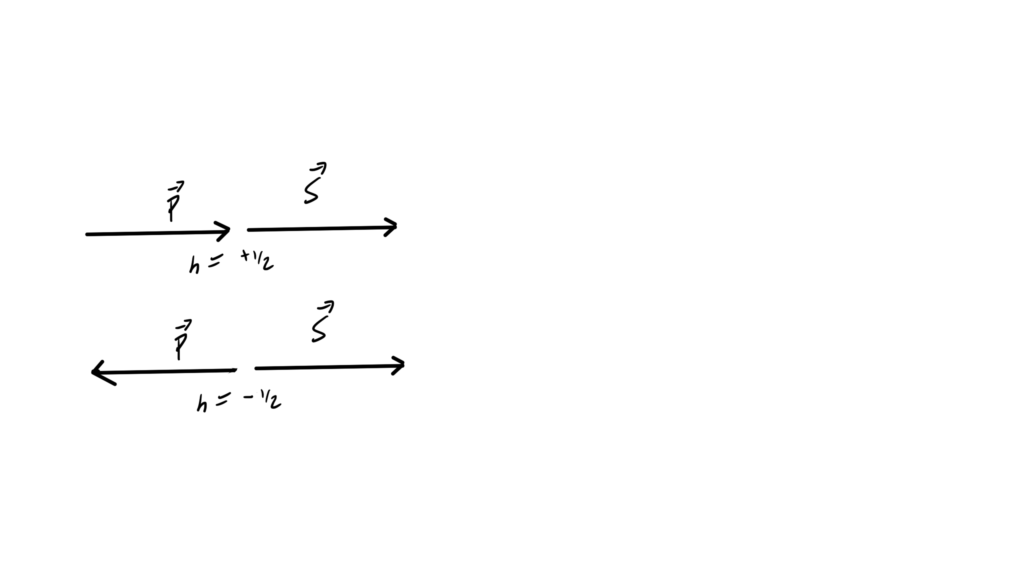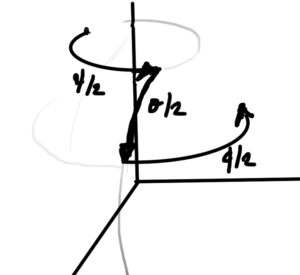[Click here for a PDF of this notes with full details.]
DISCLAIMER: Rough notes from class, with some additional side notes.
These are notes for the UofT course PHY2403H, Quantum Field Theory, taught by Prof. Erich Poppitz, fall 2018.
Overview.
See the PDF above for full notes for the first part of this particular lecture. We covered
- Normalization:
\begin{equation*}
u^{r \dagger} u^{s}
= 2 p_0 \delta^{r s}.
\end{equation*} -
Products of \( p \cdot \sigma, p \cdot \overline{\sigma} \)
\begin{equation*}
(p \cdot \sigma) (p \cdot \overline{\sigma})
=
(p \cdot \overline{\sigma}) (p \cdot \sigma)
= m^2.
\end{equation*} - Adjoint orthogonality conditions for \( u \)
\begin{equation*}
\overline{u}^r(\Bp) u^{s}(\Bp) = 2 m \delta^{r s}.
\end{equation*} -
Solutions in the \( e^{i p \cdot x} \) “direction”
\begin{equation}\label{eqn:qftLecture21:99}
v^s(p)
=
\begin{bmatrix}
\sqrt{p \cdot \sigma} \eta^s \\
-\sqrt{p \cdot \overline{\sigma}} \eta^s \\
\end{bmatrix},
\end{equation}
where \( \eta^1 = (1,0)^\T, \eta^2 = (0,1)^\T \). -
\(v\) normalization
\begin{equation*}
\begin{aligned}
\overline{v}^r(p) v^s(p) &= – 2 m \delta^{rs} \\
v^{r \dagger}(p) v^s(p) &= 2 p^0 \delta^{rs}.
\end{aligned}
\end{equation*} -
Dirac adjoint orthogonality conditions.
\begin{equation*}
\begin{aligned}
\overline{u}^r(p) v^s(p) &= 0 \\
\overline{v}^r(p) u^s(p) &= 0.
\end{aligned}
\end{equation*} -
Dagger orthogonality conditions.
\begin{equation*}
\begin{aligned}
v^{r \dagger}(-\Bp) u^s(\Bp) &= 0 \\
u^{r\dagger}(\Bp) v^s(-\Bp) &= 0.
\end{aligned}
\end{equation*} -
Tensor product.
Given a pair of vectors
\begin{equation*}
x =
\begin{bmatrix}
x_1 \\
\vdots \\
x_n \\
\end{bmatrix},
\qquad
y =
\begin{bmatrix}
y_1 \\
\vdots \\
y_n \\
\end{bmatrix},
\end{equation*}
the tensor product is the matrix of all elements \( x_i y_j \)\begin{equation*}
x \otimes y^\T =
\begin{bmatrix}
x_1 \\
\vdots \\
x_n \\
\end{bmatrix}
\otimes
\begin{bmatrix}
y_1 \cdots y_n
\end{bmatrix}
=
\begin{bmatrix}
x_1 y_1 & x_1 y_2 & \cdots & x_1 y_n \\
x_2 y_1 & x_2 y_2 & \cdots & x_2 y_n \\
x_3 y_1 & \ddots & & \\
\vdots & & & \\
x_n y_1 & \cdots & & x_n y_n
\end{bmatrix}.
\end{equation*} -
Direct product relations.
\begin{equation*}
\begin{aligned}
\sum_{s = 1}^2 u^s(p) \otimes \overline{u}^s(p) &= \gamma \cdot p + m \\
\sum_{s = 1}^2 v^s(p) \otimes \overline{v}^s(p) &= \gamma \cdot p – m \\
\end{aligned}
\end{equation*}

